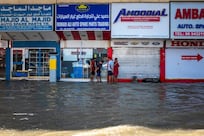After I had opened and closed an imaginary jacket, punched the air in anger, and nodded at my unknown hero with attitude, I was clutching my sides and gasping for breath.
I was having a hard time using even my hands to convey expression at a Bollywood dance class. Curious hands? Jazz hands? Punch hands? My "curious" was confused with jazz, my jazz wasn't jazzy enough and my punches were puny.
It was serious Bollywood business and, as I had suspected all along, I wasn't cut out for it.
Never mind the preferred colour of skin that the industry likes, I wasn't even going to qualify on the basic level of fitness (which the industry has recently embraced in an overwhelming way... what with even actresses sporting abs).
How and when did Bollywood arrive at such a strenuous routine? The song and dance once involved buxom women emulating a form of Indian classical dance. Soon there were background dancers. Somewhere in the 1980s troupes, sometimes numbering in their hundreds, were introduced to mimic the steps behind the actors serenading each other. Lately, though, the dance routines, much like the one I was attempting, resembled a class of Pilates-fit bodies at work.
Faster! Faster! five, six, seven, eight... the instructor pressed on. Imagine trying to do a pirouette just after you've been jumping up and down, and left to right, signalling an imaginary hero. Instead of landing on my right foot, I went headfirst towards a stack of yoga mats.
So, this was my quandary even though most attending this dance-fitness session were doing it for the fun of it (there were a few reluctant to admit to their Bollywood dreams, but still): how hard does a backup dancer work? And how much harder must a Bollywood actor practise to look like they do on screen? Let's face it, it always looks effortless.
Because believe me, this business of Bollywood dancing on screen is a nightmare. You're asked to bring the attitude and smile. You're asked to pirouette on demand.
And there I was, amid the attitude-tweaking, slight shoulder-jerking dance instructions. Rock bottom came soon enough. Unlike the 13-year-old or the 41-year-old next to me, I was not able to bring myself to co-ordinate my "curious hands" going one way with my head swinging the other way.
This weekend I watched a series of Bollywood music videos and cringed at the obvious. These intricate song and dance routines are supposed to look as effortless as possible. And no, not all Indians, including me, are up to speed on it. Yet.




